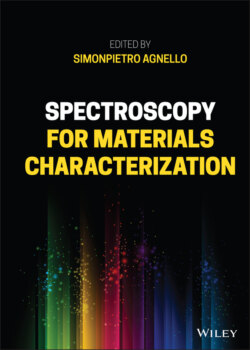Читать книгу Spectroscopy for Materials Characterization - Группа авторов - Страница 46
2.3 Case Studies: Luminescent Point Defects in Amorphous SiO2
ОглавлениеInterest toward the optical properties of point defects in amorphous SiO 2 (silica) is a timely debated issue for its fundamental aspects in the science of amorphous solids and is constantly motivated by the key role of this material in high‐tech devices, see, for instance, review papers [13, 14] and references therein. Silica is a model material both for its simple structure and for the possibility to compare its properties with those of its crystalline counterpart (α‐quartz). Moreover, due to its excellent transparency, from the mid‐IR to vacuum‐UV, is indispensable for long‐range low‐loss optical communication fibers and is the best glassy material for high‐power pulsed laser optics. Point defects are relevant because they determine a wide number of optical phenomena. They can be not only detrimental for the use of silica, as it is the case of the transmission losses, but they are also successfully exploited to build modern devices, such as fiber Bragg gratings based on the change of refractive index induced by radiation (photosensitivity). One of the most relevant optically active defects in the silica network is the oxygen dangling bond or nonbridging oxygen hole center (NBOHC), (Si─O─)3Si─O•, which is characterized by absorption bands in the visible and UV spectral range and by a luminescence around 1.9–2.0 eV, the latter being considered its optical fingerprint. NBOHC has, indeed, exceptional characteristics. On the one hand, it is common to bulk and surface silica, thus influencing several applications (the transmission of optical fibers or the emission of silica nanoparticles characterized by a high specific surface). On the other hand, NBOHC is among the intrinsic defects in oxides with the smallest electron–phonon coupling; this feature allows the site‐selective excitation/detection of the purely electronic transition or ZPL.
This section deals with the luminescence of the NBOHC at the silica surface: a model system to evidence the effectiveness of the time‐resolved technique in the study of electronic transitions and their coupling with phonons. The reported results are set in an important and timely issue concerning a wide class of optical phenomena influenced by the size reduction of materials to nanoscale. Nanometer‐sized silica particles (nanosilica) are, indeed, characterized by a large specific surface area that favors a large concentration of defects that have a crucial role in determining the high emissivity, which is surprising if compared to the optical properties of their bulk counterpart, and are therefore the subject of huge attention in the specialized literature [15–20]. It also worth noting that in these nanosystems, the generation of defects is strongly conditioned by the accessibility of surface sites for molecules of the environment [21]. This is particularly advantageous from a fundamental viewpoint because the possibility of stabilizing specific defects, by controlled thermochemical processes, is crucial to better understand their structural and electronic properties.
At silica surfaces, the structure of NBOHC is in fact determined by its generation occurring by the chemical reaction of an axially symmetric surface‐E' center, Si•, with an oxygen. Then, its symmetry is expected to be C3v , in accordance with the structure of the surface‐E' coordination sphere that is known by the electron spin resonance (ESR) properties: an axially symmetric g tensor and nearly coincident hyperfine constants due to the interaction with the 29Si atoms bonded to the three basal O [22]. In Figure 2.6a, we report the structural model of the surface NBOHC with a C 3v symmetry, where the 2p orbitals of the dangling oxygen are also shown, 2p x and 2p y . Quantum chemical calculations performed by Radzig [21] have shown that, due to the Jahn–Teller effect, the symmetry of the surface NBOHC deviates from C 3v and becomes C S , as sketched in Figure 2.6b. This removes the degeneracy of the ground state between 2p x and 2p y ; the calculated energy difference between these states is ∼0.1 eV.
Figure 2.6 Structure of the NBOHC and p orbitals of the dangling oxygen in the (panel a) C 3v and (panel b) C S symmetries.
